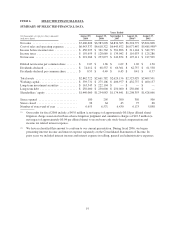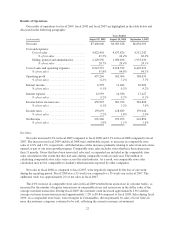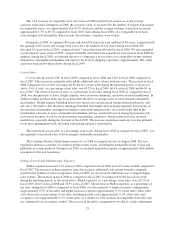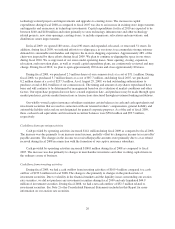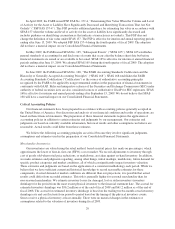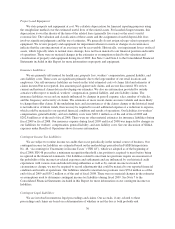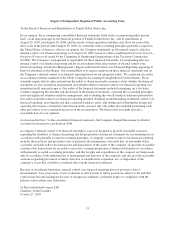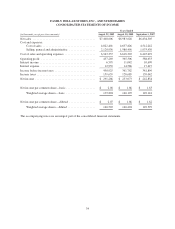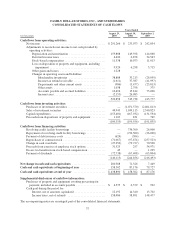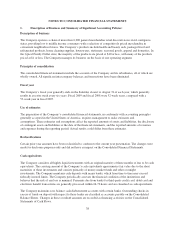Family Dollar 2009 Annual Report Download - page 37
Download and view the complete annual report
Please find page 37 of the 2009 Family Dollar annual report below. You can navigate through the pages in the report by either clicking on the pages listed below, or by using the keyword search tool below to find specific information within the annual report.In April 2009, the FASB issued FSP FAS No. 157-4, “Determining Fair Value When the Volume and Level
of Activity for the Asset or Liability Have Significantly Decreased and Identifying Transactions That Are Not
Orderly” (“FSP FAS 157-4”). This FSP provides additional guidance for estimating fair value in accordance with
SFAS 157 when the volume and level of activity for the asset or liability have significantly decreased and
includes guidance on identifying circumstances that indicate a transaction is not orderly. This FSP does not
change the definition of fair value under SFAS 157. The FSP is effective for interim and annual reporting periods
ending after June 15, 2009. We adopted FSP FAS 157-4 during the fourth quarter of fiscal 2009. The adoption
did not have a material impact on our Consolidated Financial Statements.
In May 2009, the FASB issued SFAS No. 165, “Subsequent Events” (“SFAS 165”). SFAS 165 establishes
general standards of accounting for and disclosure of events that occur after the balance sheet date but before
financial statements are issued or are available to be issued. SFAS 165 is effective for interim or annual financial
periods ending after June 15, 2009. We adopted SFAS 165 during the fourth quarter of fiscal 2009. The adoption
did not have a material impact on our Consolidated Financial Statements.
In June 2009, the FASB issued SFAS No. 168, “The FASB Accounting Standards Codification and the
Hierarchy of Generally Accepted Accounting Principles” (“SFAS 168”). SFAS 168 establishes the FASB
Accounting Standards Codification (“Codification”) as the source of authoritative accounting principles
recognized by the FASB to be applied by nongovernmental entities in the preparation of financial statements in
conformity with GAAP. Rules and interpretive releases of the Securities and Exchange Commission (SEC) under
authority of federal securities laws are also considered sources of authoritative GAAP for SEC registrants. SFAS
168 is effective for interim and annual periods ending after September 15, 2009. We do not believe that SFAS
168 will have a material impact on our Consolidated Financial Statements.
Critical Accounting Policies
Our financial statements have been prepared in accordance with accounting policies generally accepted in
the United States of America. Our discussion and analysis of our financial condition and results of operations are
based on these financial statements. The preparation of these financial statements requires the application of
accounting policies in addition to certain estimates and judgments by our management. Our estimates and
judgments are based on currently available information, historical results and other assumptions we believe are
reasonable. Actual results could differ from these estimates.
We believe the following accounting principles are critical because they involve significant judgments,
assumptions and estimates used in the preparation of our Consolidated Financial Statements.
Merchandise Inventories:
Our inventories are valued using the retail method, based on retail prices less mark-on percentages, which
approximates the lower of first-in, first-out (FIFO) cost or market. We record adjustments to inventory through
cost of goods sold when retail price reductions, or markdowns, are taken against on-hand inventory. In addition,
we make estimates and judgments regarding, among other things, initial markups, markdowns, future demand for
specific product categories and market conditions, all of which can significantly impact inventory valuation.
These estimates and judgments are based on the application of a consistent methodology each period. While we
believe that we have sufficient current and historical knowledge to record reasonable estimates for these
components, if actual demand or market conditions are different than our projections, it is possible that actual
results could differ from recorded estimates. This risk is generally higher for seasonal merchandise than for
non-seasonal merchandise. We estimate inventory losses for damaged, lost or stolen inventory (inventory
shrinkage) for the period from the most recent physical inventory to the financial statement date. The accrual for
estimated inventory shrinkage was $56.2 million as of the end of fiscal 2009 and $61.2 million as of the end of
fiscal 2008. The accrual for estimated inventory shrinkage is based on the trailing twelve-month actual inventory
shrinkage rate and can fluctuate from period to period based on the timing of the physical inventory counts.
Stores receive a physical inventory at least annually. There were no material changes in the estimates or
assumptions related to the valuation of inventory during fiscal 2009.
29


